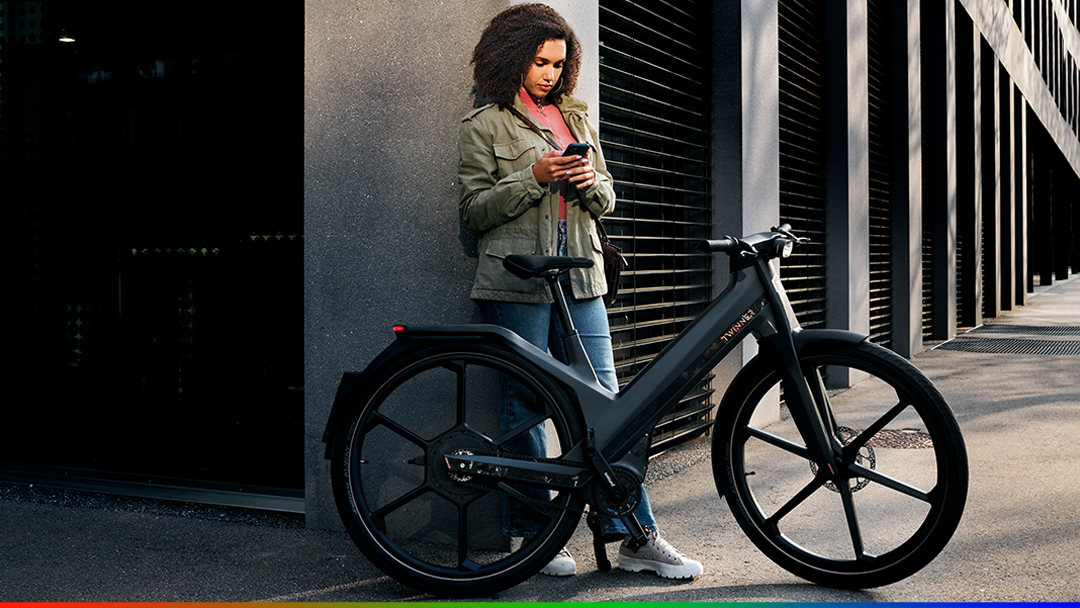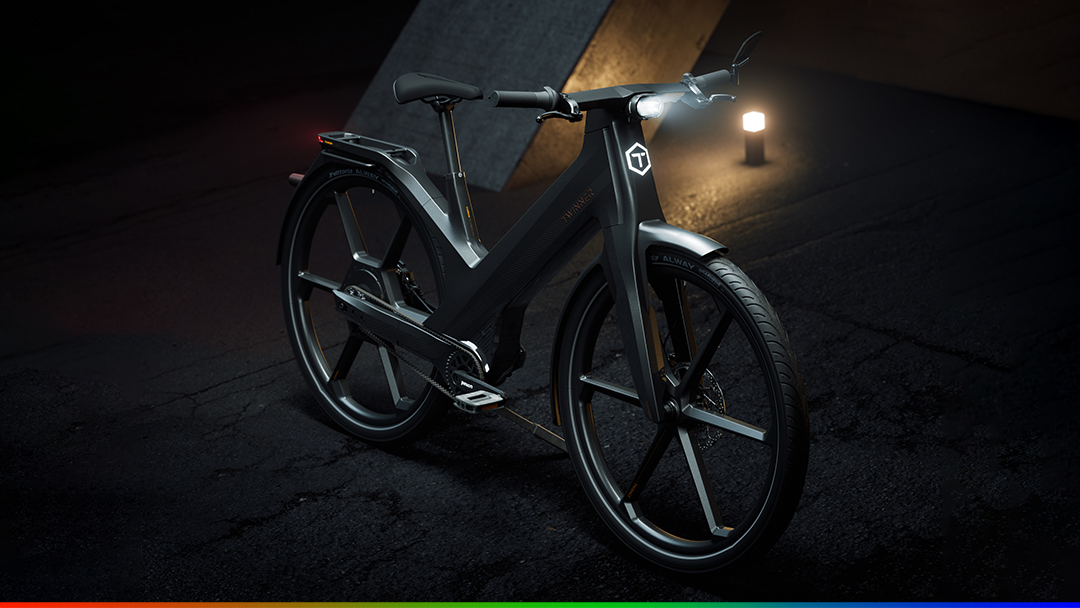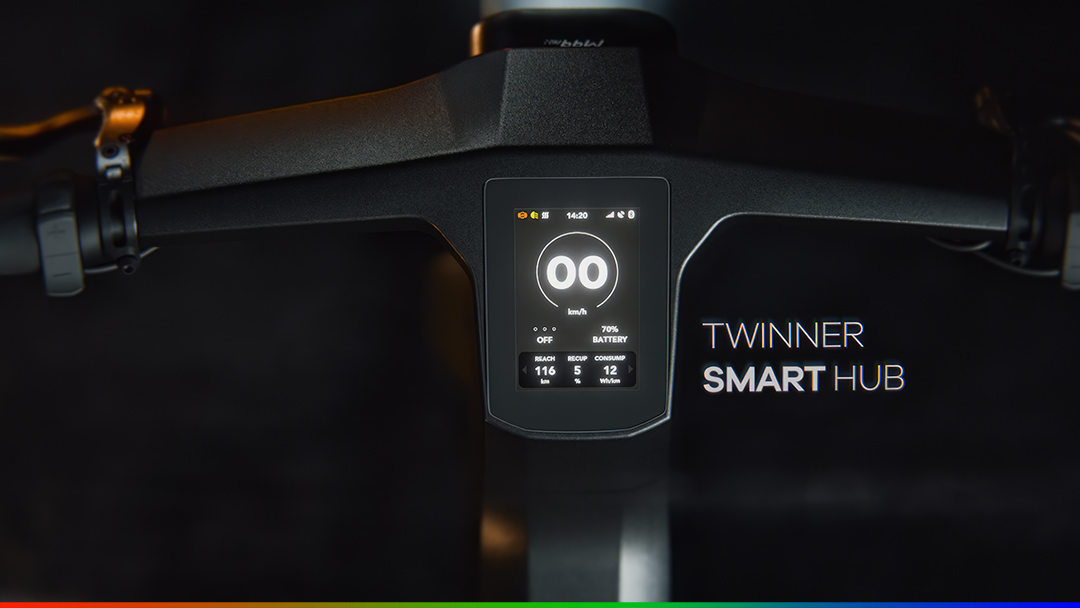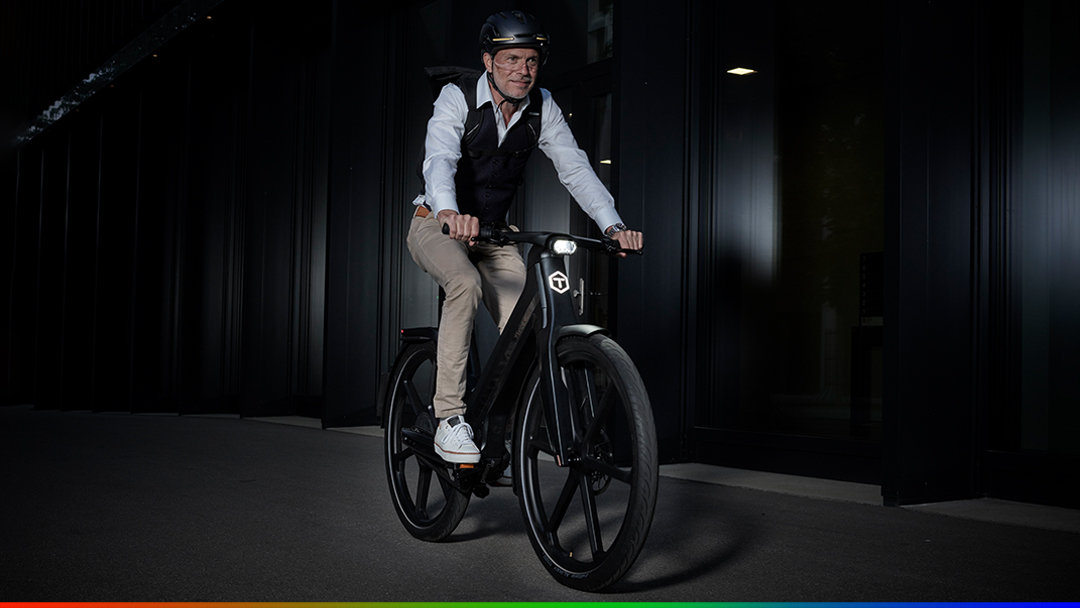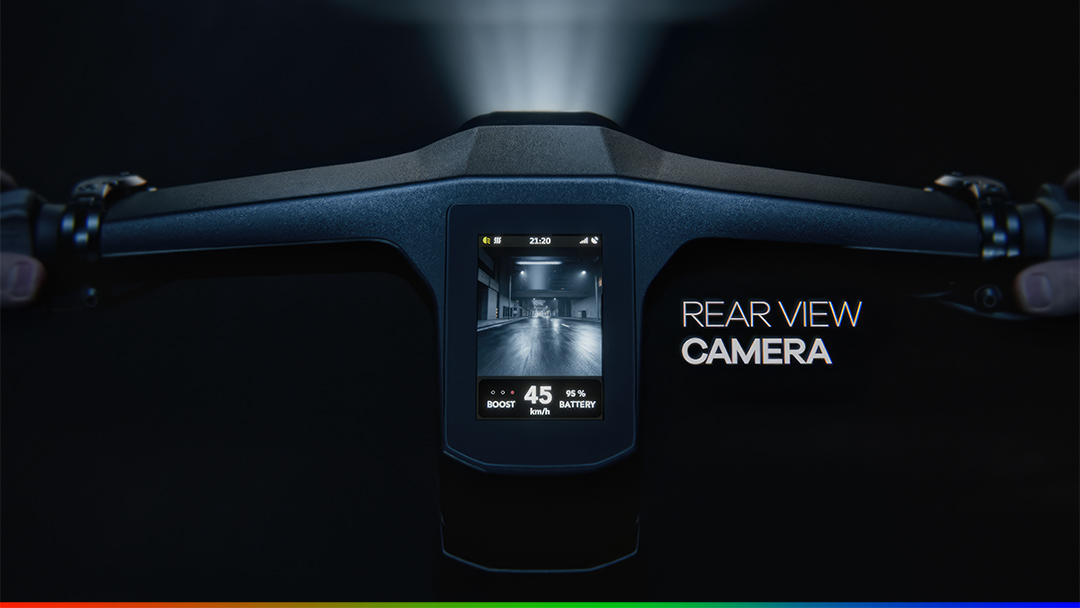E-bikes have gained enormous popularity and have become an important segment in the bicycle market. Sales of e-bikes have steadily increased in many countries and the demand for these electrically assisted bicycles remains high. There are several reasons for the continued popularity of e-bikes. For one thing, they offer an environmentally friendly alternative to conventional car transportation and help reduce emissions and congestion. For another, e-bikes make it comfortable to travel longer distances and make cycling easier on hilly terrain. People’s attitudes and habits have also changed – health awareness, sustainability and a desire for outdoor activities are important aspects of modern lifestyles.
As a result, e-bikes are still in vogue. But how do you manage to stand out from the crowd as an e-bike manufacturer with your own e-bikes? Having your own customized display from DMB Technics, integrated into the frame design, is a nifty option.
Out of the comparability thanks to customized solutions
Actually, every drive system today also includes the matching display unit. The various manufacturers sometimes offer a selection of solutions for this. Nevertheless, as a bicycle manufacturer, you are always on a par with the competition with these offerings. If you want to get out of the comparability and even aim for a plus in functionality, you can fall back on customized products. This involves a certain amount of effort, but more and more manufacturers are willing to make the effort. Support is provided by specialized companies such as DMB Technics.
The process of developing a customized display for e-bikes can be varied and sometimes very demanding. As a rule, a specification sheet is drawn up, with the requirements that the client places on the display. This sets out expectations such as the ability to display colors, the dimensions, the required resolution, and the performance data of the display. With the specifications in hand, the team is mobilized at DMB Technics in Switzerland to look at the feasibility of a defined product. The display specialist has a certain special position in the bicycle industry, since it is one of the suppliers that generally remain under the radar and are hardly ever seen by end users. This makes them all the more important for the industry, because they take on an extremely complex task in product development.
From purist to all-rounder
Before approaching a company like DMB Technics, a manufacturer must decide which goals and what demands will be placed on an e-bike. After all, the spectrum of solutions ranges from a few LEDs that simply display the charge level and assistance mode to multifunctional displays that depict every conceivable functionality, from system data to navigation. The manufacturer must be clear about what the display must be able to do. The basic question here is how the display should communicate. Is it only made for the bike itself or does it also have to be able to interact with the environment? If only basic functionalities are covered, simple, puristic solutions are sufficient. But if the customer decides on a display that needs to communicate, the project looks more complex. For example, a display that is used for navigation and allows routes to be downloaded requires a completely different usability than a simple status display. Display development also involves dealing with existing bus systems on the bike. Thus, special drivers are also co-developed if required. DMB offers the actual user software only indirectly in cooperation with the display hardware manufacturer. However, underlying functionalities are very much part of the scope of services, such as a desired Bluetooth connectivity, the power control or the control of the rear-view camera. These desired functionalities can be optionally purchased and assembled. The display specialist calls this approach, which goes far beyond a simple display, “Smart Embedded”.
Trend towards permanently integrated displays
Whether purist or all-rounder – DMB Technics sees a small trend that more and more manufacturers want to install the display firmly in the frame. The integrated variant increases stability and reliability. There are no cables, nothing can tear off, the display is protected, and it can scratch less. DMB Technics can also supply the plastic housing, the necessary mounting material, and the cables.
Core competence readability with transflective displays
The technology used shows that individualized solutions can be not only “different” but also “better”. A display that users can enjoy and read in any light is a big plus. A current trend in this direction is transflective displays. Here, the incident sunlight itself is used to improve readability. After all, the most important thing about a display is the contrast. It is assumed that a good display must have a contrast of 400 : 1. A standard that can be found in practice today. But the decisive factor is whether you measure the contrast in a protected environment without extraneous light or in the sun. And that is a challenge in the e-mobility sector. The contrast of 400 : 1 is of little use when the sun shines directly on the display. This is because so much light is generated that even high contrast values are no longer sufficient. The solution to this problem is transflective displays. Unlike transmissive displays, which are common in everyday life today, for example in smartphones, where the display only works with backlighting, transflective displays also use ambient light. The display itself is also illuminated but has additional reflective properties. If you use such a display, you can also read the screen in direct sunlight. However, you have to admit compromises with the picture quality. The decision for the right display technology therefore depends on many factors and ultimately on the priorities of the e-bike manufacturer.
Interview with Richard Günther |Sales Manager at DMB Technics
Q: Now we have heard a lot about customized display solutions for e-bikes. Can you tell me something about an already realized project with a customer?
In the past, we have already been able to implement some exciting projects with a wide variety of displays for e-bike manufacturers. From transflective displays to customized sizes, everything was there. However, a current project with a renowned e-bike manufacturer is particularly fun for me. For the e-bike manufacturer Thömus from Oberried, BE, we worked in very close partnership to design a customized smart embedded display that was fully integrated into the frame design of the new TWINNER speed pedelec.
Q: Tell us more. What kind of display was used specifically and why?
When we approach new customer projects, we first define a specification with the customer, which lays the foundation for the project. In this case, we quickly decided on a TFT display. For outdoor applications, customers have already chosen a monochrome display, which can be an advantage for readability in full sunlight. But due to the applications and additional features that Thömus wanted to include, such as touch functionalities, an appealing GUI, i.e. the display of various options such as changing gears, determining driving setups, controlling the rear-view camera, etc., only a TFT display (Smart Embedded) came into question.
After determining the type of display, the next step was to determine the size of the display. Thömus was used to define where the display should be installed in the first place. Some manufacturers decide to mount the display on the handlebars. But at Thömus, they opted for a full, elegant integration in the carbon monocoque handlebar itself. This quickly led to the 3.5-inch size, as such a display perfectly matched the thickness of the frame. In addition, the size of the display must fit the customer’s operating functions to ensure usability for the desired applications. 3.5 inches are ideal here.
To ensure a clean seal for the transmissive display, we also opted for a plastic housing in which the display with the embedded electronics and all the cabling are neatly installed. This adds to the protection and stability. The plastic housing was also fully hidden in the frame. These were the hardware facts and inputs that we considered during the development phase in the project.
Q: Were there any special design decisions regarding aesthetics and ergonomics?
The full integration looks clean and elegant. However, it is not only for cosmetic, aesthetic reasons, but also offers other benefits such as full protection and increased stability. Displays or smartphones mounted on the handlebars are naturally more exposed. Another crucial point is the user-friendliness via display that can be used in everyday life. A display with a size at the upper limit was installed precisely for this use. Thanks to the large display of the rear-view camera on the display, you also benefit from a 360° overview without turning your head.
Q: You mentioned that a Smart Embedded display was used. What is Smart Embedded all about?
Increasingly, customers expect not only the display but also the control electronics and, in some cases, the software to be supplied from a single source. In the case of the new TWINNER speed pedelec, we have therefore allowed several applications and features to be controlled directly via the display, the TWINNER Smart Hub. In order to achieve this control, such a Smart Embedded Display is required, which fulfills all the customer’s requirements in terms of software. Thömus determined the software functionalities – but our long-time supplier for Smart Embedded Displays, EDT, completely programmed and delivered the entire software. This is an additional service that we offer our customers in the Smart Embedded area in cooperation with EDT.
Q: What specific advantages does this deployed Smart Embedded Display offer?
Based on standardized, electronic components, these displays allow full customer-specific operation, which controls the entire e-bike from the display. For example, the gearshift, power management, different setups, and different levels of assistance – in other words, an extensive software affair with numerous menus and submenus. A big advantage of Smart Embedded is that the e-bike manufacturer can focus on the most important things, like design and functionality, and not waste time and money on in-house hardware development of the control electronics.
Q: How was the Smart Embedded Display (TWINNER Smart Hub) integrated into the S-Pedelec? Were there any special challenges in the process?
In this fully comprehensive project, we have everything in it that DMB currently supplies. On We offered the display, the plastic housing and the cabling as hardware on the one hand. On the other hand, we have also integrated complete smart embedded logic. An extremely complex, time-intensive project. We are talking about a development phase of around 1.5 years. Now, however, we are particularly proud that the first S-pedelecs will be on the road with our displays from October 2023.
Another challenge was coordinating delivery times of varying lengths and, in some cases, bottlenecks during the Corona period for components as well as housings and cables. The entire components had to arrive at EDT early in each case to be installed with the smart embedded logic in the e-bike test stand and also put through their paces.
Another challenging point was the control of the rear-view camera. This aspect was only added in the later development phase. The rear-view camera was not originally intended as hardware. So there can always be changes in the project, which we respond to agilely in order to meet the customer’s requirements in the best possible way.
Q: Was the smart embedded display tested by potential users or industry experts during the development process? What was the feedback like?
All the different components were delivered to EDT in advance, assembled and tested intensively. After these intensive tests, it goes to the customer for further testing. In defined weekly meetings the project successes and potentials were discussed, and the findings were implemented back into the project.
In terms of hardware, the samples were additionally tested at DMB in Switzerland via special testers. For example, the touch function was closely examined, as this is extremely important for e-bikes. You move around outside, it rains, and there are operations with or without gloves. So, we had to start defining exactly how the touch should work and what it should respond to. The thickness of the cover lens and the environment play a big role. The display must work under normal circumstances, but also in more extreme conditions. That’s a challenge we were able to solve well.
Q: Why did the e-bike manufacturer choose DMB Technics?
Because we have already been allowed to implement some interesting e-bike projects in the market and therefore have a deep know-how in this specific area, Thömus approached us. It matched and we are proud to announce that the new TWINNER is now available for purchase on the market – the delivery of the first bikes will then take place in the fall of 2023.
E-bikes have gained enormous popularity and have become an important segment in the bicycle market. Sales of e-bikes have steadily increased in many countries and the demand for these electrically assisted bicycles remains high. There are several reasons for the continued popularity of e-bikes. For one thing, they offer an environmentally friendly alternative to conventional car transportation and help reduce emissions and congestion. For another, e-bikes make it comfortable to travel longer distances and make cycling easier on hilly terrain. People’s attitudes and habits have also changed – health awareness, sustainability and a desire for outdoor activities are important aspects of modern lifestyles.
As a result, e-bikes are still in vogue. But how do you manage to stand out from the crowd as an e-bike manufacturer with your own e-bikes? Having your own customized display from DMB Technics, integrated into the frame design, is a nifty option.
Out of the comparability thanks to customized solutions
Actually, every drive system today also includes the matching display unit. The various manufacturers sometimes offer a selection of solutions for this. Nevertheless, as a bicycle manufacturer, you are always on a par with the competition with these offerings. If you want to get out of the comparability and even aim for a plus in functionality, you can fall back on customized products. This involves a certain amount of effort, but more and more manufacturers are willing to make the effort. Support is provided by specialized companies such as DMB Technics.
The process of developing a customized display for e-bikes can be varied and sometimes very demanding. As a rule, a specification sheet is drawn up, with the requirements that the client places on the display. This sets out expectations such as the ability to display colors, the dimensions, the required resolution, and the performance data of the display. With the specifications in hand, the team is mobilized at DMB Technics in Switzerland to look at the feasibility of a defined product. The display specialist has a certain special position in the bicycle industry, since it is one of the suppliers that generally remain under the radar and are hardly ever seen by end users. This makes them all the more important for the industry, because they take on an extremely complex task in product development.
From purist to all-rounder
Before approaching a company like DMB Technics, a manufacturer must decide which goals and what demands will be placed on an e-bike. After all, the spectrum of solutions ranges from a few LEDs that simply display the charge level and assistance mode to multifunctional displays that depict every conceivable functionality, from system data to navigation. The manufacturer must be clear about what the display must be able to do. The basic question here is how the display should communicate. Is it only made for the bike itself or does it also have to be able to interact with the environment? If only basic functionalities are covered, simple, puristic solutions are sufficient. But if the customer decides on a display that needs to communicate, the project looks more complex. For example, a display that is used for navigation and allows routes to be downloaded requires a completely different usability than a simple status display. Display development also involves dealing with existing bus systems on the bike. Thus, special drivers are also co-developed if required. DMB offers the actual user software only indirectly in cooperation with the display hardware manufacturer. However, underlying functionalities are very much part of the scope of services, such as a desired Bluetooth connectivity, the power control or the control of the rear-view camera. These desired functionalities can be optionally purchased and assembled. The display specialist calls this approach, which goes far beyond a simple display, “Smart Embedded”.
Trend towards permanently integrated displays
Whether purist or all-rounder – DMB Technics sees a small trend that more and more manufacturers want to install the display firmly in the frame. The integrated variant increases stability and reliability. There are no cables, nothing can tear off, the display is protected, and it can scratch less. DMB Technics can also supply the plastic housing, the necessary mounting material, and the cables.
Core competence readability with transflective displays
The technology used shows that individualized solutions can be not only “different” but also “better”. A display that users can enjoy and read in any light is a big plus. A current trend in this direction is transflective displays. Here, the incident sunlight itself is used to improve readability. After all, the most important thing about a display is the contrast. It is assumed that a good display must have a contrast of 400 : 1. A standard that can be found in practice today. But the decisive factor is whether you measure the contrast in a protected environment without extraneous light or in the sun. And that is a challenge in the e-mobility sector. The contrast of 400 : 1 is of little use when the sun shines directly on the display. This is because so much light is generated that even high contrast values are no longer sufficient. The solution to this problem is transflective displays. Unlike transmissive displays, which are common in everyday life today, for example in smartphones, where the display only works with backlighting, transflective displays also use ambient light. The display itself is also illuminated but has additional reflective properties. If you use such a display, you can also read the screen in direct sunlight. However, you have to admit compromises with the picture quality. The decision for the right display technology therefore depends on many factors and ultimately on the priorities of the e-bike manufacturer.
Interview with Richard Günther |Sales Manager at DMB Technics
Q: Now we have heard a lot about customized display solutions for e-bikes. Can you tell me something about an already realized project with a customer?
In the past, we have already been able to implement some exciting projects with a wide variety of displays for e-bike manufacturers. From transflective displays to customized sizes, everything was there. However, a current project with a renowned e-bike manufacturer is particularly fun for me. For the e-bike manufacturer Thömus from Oberried, BE, we worked in very close partnership to design a customized smart embedded display that was fully integrated into the frame design of the new TWINNER speed pedelec.
Q: Tell us more. What kind of display was used specifically and why?
When we approach new customer projects, we first define a specification with the customer, which lays the foundation for the project. In this case, we quickly decided on a TFT display. For outdoor applications, customers have already chosen a monochrome display, which can be an advantage for readability in full sunlight. But due to the applications and additional features that Thömus wanted to include, such as touch functionalities, an appealing GUI, i.e. the display of various options such as changing gears, determining driving setups, controlling the rear-view camera, etc., only a TFT display (Smart Embedded) came into question.
After determining the type of display, the next step was to determine the size of the display. Thömus was used to define where the display should be installed in the first place. Some manufacturers decide to mount the display on the handlebars. But at Thömus, they opted for a full, elegant integration in the carbon monocoque handlebar itself. This quickly led to the 3.5-inch size, as such a display perfectly matched the thickness of the frame. In addition, the size of the display must fit the customer’s operating functions to ensure usability for the desired applications. 3.5 inches are ideal here.
To ensure a clean seal for the transmissive display, we also opted for a plastic housing in which the display with the embedded electronics and all the cabling are neatly installed. This adds to the protection and stability. The plastic housing was also fully hidden in the frame. These were the hardware facts and inputs that we considered during the development phase in the project.
Q: Were there any special design decisions regarding aesthetics and ergonomics?
The full integration looks clean and elegant. However, it is not only for cosmetic, aesthetic reasons, but also offers other benefits such as full protection and increased stability. Displays or smartphones mounted on the handlebars are naturally more exposed. Another crucial point is the user-friendliness via display that can be used in everyday life. A display with a size at the upper limit was installed precisely for this use. Thanks to the large display of the rear-view camera on the display, you also benefit from a 360° overview without turning your head.
Q: You mentioned that a Smart Embedded display was used. What is Smart Embedded all about?
Increasingly, customers expect not only the display but also the control electronics and, in some cases, the software to be supplied from a single source. In the case of the new TWINNER speed pedelec, we have therefore allowed several applications and features to be controlled directly via the display, the TWINNER Smart Hub. In order to achieve this control, such a Smart Embedded Display is required, which fulfills all the customer’s requirements in terms of software. Thömus determined the software functionalities – but our long-time supplier for Smart Embedded Displays, EDT, completely programmed and delivered the entire software. This is an additional service that we offer our customers in the Smart Embedded area in cooperation with EDT.
Q: What specific advantages does this deployed Smart Embedded Display offer?
Based on standardized, electronic components, these displays allow full customer-specific operation, which controls the entire e-bike from the display. For example, the gearshift, power management, different setups, and different levels of assistance – in other words, an extensive software affair with numerous menus and submenus. A big advantage of Smart Embedded is that the e-bike manufacturer can focus on the most important things, like design and functionality, and not waste time and money on in-house hardware development of the control electronics.
Q: How was the Smart Embedded Display (TWINNER Smart Hub) integrated into the S-Pedelec? Were there any special challenges in the process?
In this fully comprehensive project, we have everything in it that DMB currently supplies. On We offered the display, the plastic housing and the cabling as hardware on the one hand. On the other hand, we have also integrated complete smart embedded logic. An extremely complex, time-intensive project. We are talking about a development phase of around 1.5 years. Now, however, we are particularly proud that the first S-pedelecs will be on the road with our displays from October 2023.
Another challenge was coordinating delivery times of varying lengths and, in some cases, bottlenecks during the Corona period for components as well as housings and cables. The entire components had to arrive at EDT early in each case to be installed with the smart embedded logic in the e-bike test stand and also put through their paces.
Another challenging point was the control of the rear-view camera. This aspect was only added in the later development phase. The rear-view camera was not originally intended as hardware. So there can always be changes in the project, which we respond to agilely in order to meet the customer’s requirements in the best possible way.
Q: Was the smart embedded display tested by potential users or industry experts during the development process? What was the feedback like?
All the different components were delivered to EDT in advance, assembled and tested intensively. After these intensive tests, it goes to the customer for further testing. In defined weekly meetings the project successes and potentials were discussed, and the findings were implemented back into the project.
In terms of hardware, the samples were additionally tested at DMB in Switzerland via special testers. For example, the touch function was closely examined, as this is extremely important for e-bikes. You move around outside, it rains, and there are operations with or without gloves. So, we had to start defining exactly how the touch should work and what it should respond to. The thickness of the cover lens and the environment play a big role. The display must work under normal circumstances, but also in more extreme conditions. That’s a challenge we were able to solve well.
Q: Why did the e-bike manufacturer choose DMB Technics?
Because we have already been allowed to implement some interesting e-bike projects in the market and therefore have a deep know-how in this specific area, Thömus approached us. It matched and we are proud to announce that the new TWINNER is now available for purchase on the market – the delivery of the first bikes will then take place in the fall of 2023.


